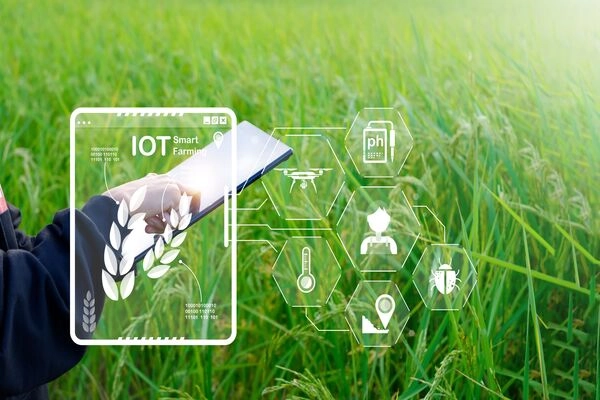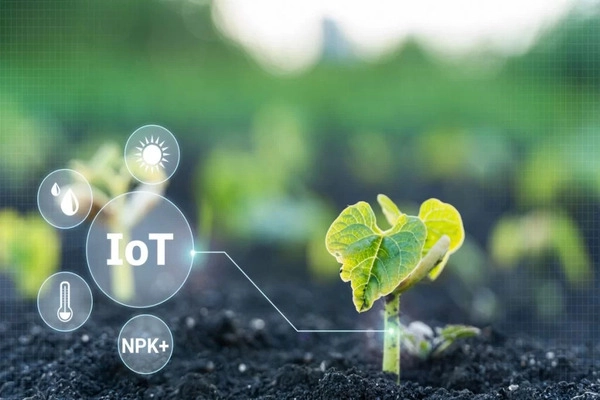IoT in agriculture is becoming a key technological trend, helping Vietnamese farmers increase productivity, optimize resources, and manage smart farms more efficiently. With Internet-connected devices such as sensors, robots, and drones, monitoring crops and environmental conditions has become more accurate and timely than ever. This article explores the most common IoT technologies, their benefits, and the challenges of applying them in Vietnamese agriculture.
What is IoT in agriculture?
IoT in agriculture (Internet of Things in Agriculture) refers to the use of Internet-connected devices such as sensors, measurement tools, automated machinery, and intelligent data systems in the agricultural production process. Its main goal is to collect and analyze data from the environment and crops to help farmers make precise decisions, optimize productivity, and reduce costs.

Instead of relying solely on manual experience and observation, IoT enables farmers to monitor their farms in real time, forecast crop conditions, control the environment, and improve overall management efficiency. The development of IoT has ushered in a new era for Vietnamese agriculture, where technology not only supports production but also creates added value through data and automation.
Common IoT Technologies Used in Agriculture
IoT applications in agriculture today are diverse, ranging from monitoring soil and environmental conditions to using smart machinery. These technologies help increase productivity, reduce costs, and minimize risks in farming. Below are some of the most common IoT technologies and how they support modern agriculture.
Smart Agricultural Robots
Agricultural robots are among the most advanced IoT technologies, designed to perform automated tasks such as seeding, harvesting, pruning, and crop care. Equipped with sensors and data systems, these robots can assess crop conditions, detect pests, and adjust their operations accordingly. Using robots reduces manual labor, increases precision in farming, and boosts overall agricultural productivity.

Camera Technology and Crop Monitoring Sensors
Camera technology and sensors play a crucial role in monitoring crop growth. Sensors can measure soil moisture, temperature, light, and nutrient levels, providing early warnings of growth issues. AI-integrated camera systems are capable of analyzing images to detect pests, assess leaf conditions, and estimate yield. This solution allows farmers to proactively manage their crops and reduce the risk of crop loss.
Using Drones in Agriculture
Drones have become an essential tool in IoT-based agriculture due to their ability to monitor large areas and collect data quickly. Equipped with cameras and sensors, drones can check crop health, detect pests, water plants, and apply fertilizers with precision. This enables farmers to monitor production in real time and make accurate farming decisions, minimizing losses and waste.

Remote Sensors for Monitoring Environment and Soil
Remote sensors are an essential component of IoT in agriculture. They enable continuous monitoring of environmental parameters such as soil moisture, pH, temperature, light, and nutrient levels. The collected data is sent to a central system for analysis, providing farmers with alerts and recommendations. This helps optimize irrigation, fertilization, and soil management in a smart and efficient way.
Benefits of IoT in Agriculture
The application of IoT brings numerous practical benefits, not only enhancing productivity but also promoting sustainable and modern agricultural practices.

Improving Efficiency and Crop Yield
Thanks to the data collected and analyzed, farmers can make more accurate decisions regarding planting schedules, irrigation, fertilization, and pest control. This helps crops grow optimally, reduces the risk of crop loss, and increases overall agricultural productivity.
Promoting Smart Farming Models
IoT serves as the foundation for Smart Farming. Smart farms use IoT to connect the entire system—from soil, water, and crops to production equipment. As a result, all farming activities are automated, monitored, and optimized in real time, enhancing management efficiency and increasing the value of agricultural products.
Saving Time and Optimizing Resources
The use of robots, drones, and IoT sensors significantly reduces manual labor and saves time in tasks such as planting, irrigation, and harvesting. At the same time, IoT data allows for more efficient use of resources like water, fertilizers, and labor, minimizing waste and maximizing profits.
Reducing Resource Consumption and Production Costs
IoT in agriculture enables precise monitoring of crop needs, allowing farmers to adjust the amount of water, fertilizers, and pesticides accordingly. This not only protects the environment but also reduces production costs, minimizes waste, and improves economic efficiency for farmers.
Enhancing Safety, Cleanliness, and Crop Quality
By closely controlling the production process—from soil management, fertilization, irrigation to harvesting—agricultural products become safer, cleaner, and of higher quality. This is especially important given the increasing standards for food safety and hygiene.
Challenges of Applying IoT in Vietnamese Agriculture
Although IoT brings many benefits, its implementation in Vietnam still faces several significant challenges.

Limited Network Infrastructure
Many rural areas in Vietnam still lack stable Internet coverage, especially 4G and 5G connectivity. This makes it difficult to transmit real-time data from sensors, drones, or agricultural robots to central systems for analysis and decision-making.
High Initial Investment Costs
IoT devices such as robots, drones, sensors, and data analysis systems require significant capital investment. This presents a barrier for many small farmers and farms, limiting the adoption of IoT on a small scale or in a coordinated manner.
Lack of Technical Expertise and IoT Skills
To effectively operate and utilize IoT systems, farmers and technicians need knowledge in technology, data analysis, and system management. Currently, the skilled workforce in Vietnam is limited, making it challenging to implement and maintain IoT devices.
IoT in agriculture is opening a new era for Vietnamese farming, helping to increase productivity, reduce costs, optimize resources, and improve the quality of agricultural products. However, to fully realize its potential, challenges related to infrastructure, investment costs, and technical expertise must be addressed. Once these factors are improved, IoT will become a key solution, driving smart, sustainable, and competitive agriculture in the global market.
